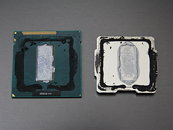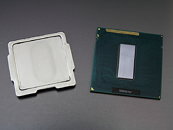Saturday, May 12th 2012

TIM is Behind Ivy Bridge Temperatures After All
It's proven: the thermal interface material (TIM) used by Intel, inside the integrated heatspreader (IHS) of its Core "Ivy Bridge" processors are behind its higher than expected load temperatures. This assertion was first made in late-April by an Overclockers.com report, and was recently put to test by Japanese tech portal PC Watch, in which an investigator carefully removed the IHS of a Core i7-3770K processor, removed the included TIM and binding grease, and replaced them with a pair of aftermarket performance TIMs, such as OCZ Freeze and Coolaboratory Liquid Pro.
PC Watch findings show that swapping the TIM, if done right, can shave stock clock (3.5 GHz, Auto voltage) temperatures by as much as 18% (lowest temperatures by the Coolaboratory TIM), and 4.00 GHz @ 1.2V temperatures by as much as 23% (again, lowest temperatures on the Coolaboratory TIM). The change in TIM was also change the overclockability of the chip, which was then able to sustain higher core voltages to facilitate higher core clock speeds. The report concluded that Intel's decision to use thermal paste inside the IHS of its Ivy Bridge chips, instead of fluxless solder, poses a very real impact on temperatures and overclockability.
Source:
PC Watch
PC Watch findings show that swapping the TIM, if done right, can shave stock clock (3.5 GHz, Auto voltage) temperatures by as much as 18% (lowest temperatures by the Coolaboratory TIM), and 4.00 GHz @ 1.2V temperatures by as much as 23% (again, lowest temperatures on the Coolaboratory TIM). The change in TIM was also change the overclockability of the chip, which was then able to sustain higher core voltages to facilitate higher core clock speeds. The report concluded that Intel's decision to use thermal paste inside the IHS of its Ivy Bridge chips, instead of fluxless solder, poses a very real impact on temperatures and overclockability.




219 Comments on TIM is Behind Ivy Bridge Temperatures After All
Anyway... I did read those posts about cheap grease being the possible culprit to ivy's higher temps, but not being much of an OCer it didnt deter me and I must say Im pretty happy with the temps on mine so far.
Those are cooler than average temps. Typical idle so far is about 30c, all Ive done with the chip is EZ mode ^.^ Gaming has the chip running @4.22 on 1.19V which results in max 51c
I has few Athlon X2 (65nm/90nm) running with waterblock directly on the Core. No matter how much voltage i pumped into the CPU, the temperatures were always great!
I hope AMD doesthe same thing with their new FX line.
If you don't care about watercooling the CPU for max overclock or low temperature, then just ignore me:D
Also, how about ditching the IHS altogether and attaching the cooler directly to the core, or will the pressure cause it to crack?
1) I'm lazy and I could have done that graph
2) No video
3) The OC just looks lazy like .05. More of a graph you find on the back of the Freeze and Liquid Pro so back to 1^
4) From the few pics hes got up there this guy is no Doctor with his hands.
5) I cant read spanish that well
6) W1z didnt include a temp review on the Ivy-Bridge so i'll have to say it isnt true
:p
Fortunately for me, I'm not shopping for a CPU.
Still, no reason for me to ditch the trusty 2500K in sight :D
Anyways if they were insane enough to do that for extreme clockers (like .001% of buyers) they'd of said something about it to put a positive spin on this mess.
As far as this topic, maybe Intel can fix the temparatures with an stepping revision?